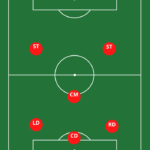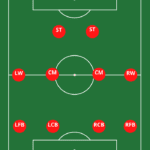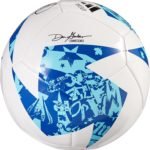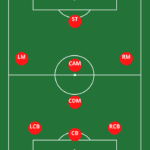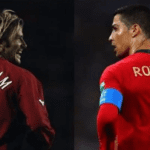- Last Updated -
The importance of understanding positions in soccer
Opinions vary on what the hardest position in soccer is… Soccer is a game where every player on the field has a specific role to play. Every soccer position requires different skills, strengths, and abilities.
Understanding these positions is essential for players, coaches, and fans alike. In this article we will try and answer the question… what is the hardest soccer position to play…
Each player’s role can make the difference between winning or losing the game. Soccer challenges each position differently, even at the highest level of play.
The goalkeeper needs to be alert and quick on their feet to prevent goals from going in at all times. The striker needs to be fast and agile enough to outmaneuver defenders while maintaining focus on scoring goals.
Midfielders need excellent dribbling skills, accurate passing ability, and good communication with both forwards and defenders. Professional opinions have been voiced about which soccer position is the hardest.
Many experts agree that the goalkeeper has one of the most challenging jobs due to their unique role as a last line of defense against opposing teams’ attacks. They must constantly assess situations in front of them while also remaining vigilant for any potential threats behind them.
Understanding soccer positions is crucial in developing game plans that cater to each player’s strengths and abilities. Coaches must consider factors such as playing style, skillset, and fitness level when deciding where best to place each player on their team.
Understanding soccer positions is vital for success in this beautiful game. It allows players, coaches, and fans alike to appreciate each position’s unique challenges fully and gain a deeper appreciation for what it takes to succeed in soccer at any level of play.
Understanding Soccer Positions
When it comes to understanding soccer positions, it’s important to start with the basics. Soccer is typically played with 11 players per team, each with a specific role on the field. These roles are divided into four main categories: defenders, midfielders, forwards (or attackers), and the goalkeeper.
Each player has a unique job that contributes to the success of their team. Defenders are responsible for protecting their team’s goal and preventing the opposing team from scoring.
They usually stand in front of their goalkeeper and use their bodies to intercept passes or block shots. Midfielders play a more versatile role, transitioning between defense and offense as needed.
They’re often tasked with controlling possession of the ball and distributing it to their teammates. Forwards are responsible for scoring goals – arguably the most exciting part of any soccer game!
They use speed and skill to maneuver around defenders and take shots on goal. We have the goalkeeper – perhaps one of the most crucial positions on the field.
As mentioned earlier, they’re responsible for guarding their team’s goal line by blocking shots or intercepting crosses. Overall, understanding soccer positions is essential for any aspiring player or fan alike.
It helps us appreciate just how much work goes into each position! While each position comes with its own set of challenges, they all work together in harmony to achieve victory on game day!
Roles and responsibilities of each position
When it comes to soccer, there are several positions that a player can take on the field, each with its own unique set of roles and responsibilities. Understanding these positions is crucial for players to work together effectively as a team and achieve success on the field.
In this section, we will discuss the different positions in soccer and what each player’s role entails. Let’s start with the goalkeeper.
As perhaps the most important position in soccer, the goalkeeper is responsible for defending their team’s goalpost and preventing opposing teams from scoring. They need to have quick reflexes, excellent spatial awareness, and be able to anticipate shots regardless of their speed or trajectory.
Additionally, goalkeepers must also be able to communicate well with their defensive line so that they can coordinate themselves effectively during set pieces or counter-attacks. Moving on to strikers – they are typically responsible for leading an attack and scoring goals for their team.
Strikers must possess excellent shooting accuracy coupled with quick thinking, agility, and strength. They must also maintain good positioning on the field because their primary objective is always to be in a position where they can score a goal.
Midfielders are considered by many professionals as the heart of soccer since they play an essential role in both defense and attack. Their job is mainly focused on creating opportunities for other players by passing balls forward while simultaneously blocking opposing teams’ attacks by intercepting passes or tackling opposition players effectively while staying within their zones.
As you can see from these professional opinions about soccer positions; each position requires specific skill sets that make them challenging to master individually – let alone working seamlessly together as a team unit!
But regardless of which position you play, understanding your role’s responsibilities will help you better contribute towards achieving your team’s ultimate goal – winning games!

The Goalkeeper: The Hardest Position in Soccer?
The goalkeeper is undoubtedly the most critical position in soccer.
This position is responsible for protecting the goalpost and saving the team from conceding a goal. Professional opinions suggest that this position requires a unique set of skills such as excellent hand-eye coordination, agility, speed, and quick reflexes.
Goalkeepers must be able to make split-second decisions and react quickly to the ball’s trajectory. They also need excellent communication skills to communicate with their defenders about how they want the game played.
Goalkeepers often have to deal with high-pressure situations where one mistake can cost the team points or even an important match. Soccer challenges even further elevate the difficulties faced by a goalkeeper.
A goalkeeper‘s role is not limited to saving goals; they also have to play an active role in initiating attacks and distributing passes when their team is on the offensive. Moreover, due to tactical changes in soccer formations that teams use, there are more demands on goalkeepers than ever before, requiring them to adapt quickly and be versatile enough to handle different situations effectively.
It’s no surprise that professional opinions often consider the goalkeeper as the hardest position in soccer. With their unique skillset, ability to make split-second decisions under immense pressure, and adaptability required for modern-day football formations – being a great goalkeeper requires much more than just raw athleticism!
The Striker: A Close Second
When it comes to the hardest position in soccer, the goalkeeper often takes the cake. However, there is another position that comes very close in difficulty: the striker.
The striker’s main responsibility is to score goals for their team. This means they must have a strong understanding of timing, positioning, and accuracy when shooting.
Not only do they need to be skilled at scoring goals themselves, but they also need to know how to set up their teammates for goal-scoring opportunities. One of the biggest challenges that strikers face is dealing with pressure from defenders.
They are constantly being marked and pressured by opposition players who are trying to prevent them from scoring. This requires a high level of physical strength as well as mental toughness.
Strikers must be able to stay focused and composed even when under intense pressure. Another challenge that strikers face is dealing with changing game situations.
Depending on the scoreline and time left in the game, their role may shift from being a scorer to being a facilitator for their teammates or even acting as an extra defender in certain situations toward the end of games. Strikers must be able to adapt quickly based on what’s happening on the field.
Professional opinions vary when it comes to ranking positions by difficulty, but one thing is clear: both goalkeepers and strikers face unique challenges that require exceptional skills and mental toughness.
While some may argue that one position is harder than the other, it’s important to recognize that all soccer positions come with their own set of challenges and each one plays an important role in achieving team success on the field.
Midfield Positions: The Heart of the Game
The midfield positions in soccer are some of the most challenging and demanding roles on the field.
These players are responsible for connecting defense to attack, making decisive passes, and breaking up play. They must also have excellent stamina and be able to cover a lot of ground during the game.
As such, midfielders in soccer face a lot of challenges. One of the biggest challenges that midfielders face is maintaining possession.
Whether it’s through dribbling or passing, they need to keep control of the ball while under pressure from opposing players. This requires excellent technical skills and quick decision-making ability.
Midfielders must be able to read the game well and anticipate their opponents’ movements in order to make successful passes. Another challenge that midfielders often face is staying disciplined defensively.
While they may have attacking responsibilities, they also need to support their defenders by tracking back when necessary and stopping opposing attacks from building up momentum. This requires good positioning and awareness on the field.
Professional opinions suggest that midfield players are some of the most important players on any team because they are involved in almost every aspect of the game – both defensively and offensively. They can create scoring opportunities, as well as stop them from happening by breaking up opposition attacks and intercepting passes.
Overall, being a midfielder in soccer is a difficult task that requires skill, discipline, stamina, and intelligence on the field. It’s not surprising then that many professional soccer players consider this position to be one of the hardest ones on a team besides goalkeeper!
Why these positions are challenging
Being a professional soccer player is not an easy feat. It requires great physical strength, mental agility, and emotional stability.
When it comes to soccer positions, each role presents its own unique challenges and difficulties. In this section of the article, we will delve deeper into some reasons why certain positions can be more challenging than others.
Firstly, let’s talk about the goalkeeper position. The goalkeeper position is known as the hardest position in soccer due to its high level of responsibility and pressure.
They are required to save goals from the opposing team while also ensuring their team doesn’t concede any points during a match. This means that they must have exceptional hand-eye coordination, quick reflexes, and be able to make split-second decisions.
The striker position also presents its own set of challenges and difficulties. Strikers are expected to score goals for their teams while under immense pressure from defenders trying to stop them at every turn.
They need to be quick on their feet, have excellent ball control skills, and be able to read the game well to anticipate where the ball is going next. Midfield positions such as central midfielders or defensive midfielders require high levels of stamina and endurance due to their constant running up and down the field.
They must also have excellent passing skills as they often serve as connectors between defense and offense lines. Understanding why certain soccer positions are challenging is important in appreciating all aspects of this beautiful game.
Whether you’re a casual fan or an aspiring professional player yourself, it’s important to acknowledge these challenges and appreciate the hard work that goes into playing at such a high level. Keep these factors in mind when watching or playing soccer next time!

The Fullback: A Complete Player
When it comes to soccer positions, the fullback is often overlooked. However, this position requires players to be complete and versatile.
Fullbacks are expected to defend their side of the field while also supporting their team’s offense by creating chances and assisting goals. One of the key responsibilities of a fullback is marking opposing attackers, which can be quite challenging.
It’s not just about keeping up with opponents’ pace – fullbacks also need to anticipate their movements and block them from scoring opportunities. Professional opinions suggest that good timing is crucial when it comes to tackling as well as intercepting passes.
In addition to defending, fullbacks need to be able to cover a lot of ground during the attack as well. They work closely with midfielders and wingers on their side of the field, overlapping runs and making crosses into the box.
This requires stamina, speed, and good ball control skills. Soccer challenges that arise for fullbacks include facing fast-paced wingers who can outrun them or pass them with ease.
Another aspect that makes this position challenging is its demand for adaptability. Fullbacks often have to switch between playing on the left or right sides depending on coaches’ tactics or injuries in the team.
They also need to be comfortable playing in both defensive and attacking roles based on game situations. In other words, being a complete player in all aspects of soccer is essential for a successful fullback career!
The Sweeper: The Last Line of Defense
When it comes to soccer positions, the sweeper is often overlooked.
However, it is an essential role in any team. The sweeper’s main responsibility is to be the last line of defense before the goalkeeper.
They have to be quick and agile as they need to sprint back and forth on the field to prevent any goal-scoring opportunities for the opposing team. Soccer Challenges for Sweepers
One of the most significant challenges for sweepers is their mental strength. This position requires them to read and anticipate their opponent’s movements, which can be mentally taxing during long games.
They also have to communicate effectively with their teammates, especially with defenders and midfield players in front of them. Goalkeeper-Sweeper Cooperation
Sweepers usually work closely with goalkeepers as they are the goalkeeper‘s eyes on the pitch. They help direct their teammates around them and signal any danger they spot before it turns into a goal-scoring opportunity.
Additionally, sweepers need a good understanding of how goalkeepers play so that they can adjust themselves accordingly during game situations. Professional Opinions
Many professional soccer players have acknowledged that sweepers are vital in ensuring a team’s success on the field. For instance, Paolo Maldini from Italy was known for his outstanding performance as a sweeper who was able to read situations well and maintain control over his area effectively.
While not as glamorous or upfront as some other positions on the field, sweepers play an essential role in keeping goals out of their own net by being a reliable last line of defense. Their skills range from reading plays accurately and quickly moving back and forth across large sections of turf;
all while keeping mental agility up amid significant pressure throughout long games or tournaments against tough competitors- requiring not just physical strength but also excellent communication skills with both defenders and midfield players ahead who rely on them heavily too.
Expert Opinions in soccer
To gain some insight into what professionals think about the hardest position in soccer, we’ve gathered some quotes from well-known players and coaches. Here are a few of their thoughts:
Jose Mourinho, a renowned Portuguese coach, believes that goalkeeping is the toughest position in soccer. He has said that “there is no greater individual challenge than being a goalkeeper,” and he’s right.
Goalkeepers have to be ready for anything, and they need to be mentally strong to handle the pressure that comes with being the last line of defense. On the other hand, former striker Gary Lineker thinks that scoring goals is one of the most difficult things to do in soccer.
He’s not wrong; strikers have to possess excellent ball-control skills and be able to outsmart defenders who are trying to prevent them from scoring. Even then, they still have to beat the goalkeeper.
Former midfielder Roy Keane has spoken about how demanding it can be to play as a central midfielder. According to him: “It can be an incredibly challenging position because you’re expected to contribute in both attack and defense.”
The midfielders’ role is crucial since they are responsible for linking up the defense with attacking players.
These professional opinions provide us with a glimpse into how challenging each position can be. While opinions will always vary when it comes down to which positions are hardest or not, what all players agree on is that soccer challenges individuals physically and mentally regardless of their position on the field.
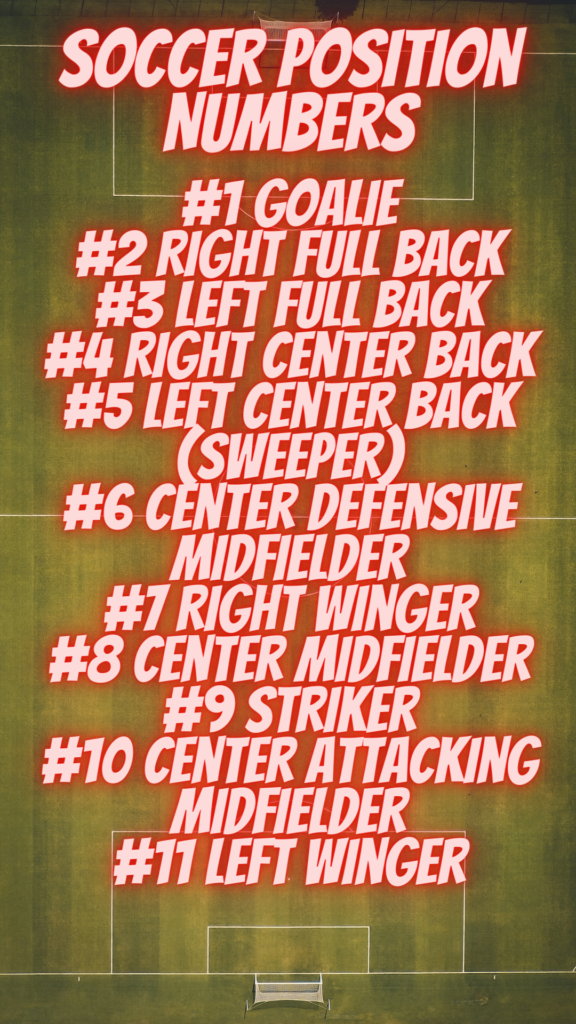
Conclusion
Soccer is a fascinating game with its unique positions, and each player has a critical role in the team’s success. Understanding the positions and their challenges can help both players and fans appreciate the game better.
poses several challenges that make it one of the most challenging sports globally, and position plays a critical role in determining a player’s effectiveness.
While all positions have their unique challenges, some stand out as particularly hard. The goalkeeper stands out as the hardest position in soccer due to the immense pressure they face as the last line of defense against goal-scoring attempts.
Professional opinions about soccer positions are diverse, but most experts agree that each position comes with its unique set of challenges. For instance, strikers need to be fast, agile, and skillful at shooting accurately to score goals for their team.
Midfielders require good passing ability and stamina since they cover lots of ground every game while supporting both attack and defense. Understanding soccer positions is essential for any fan or player looking to appreciate this exciting sport better.
Each position comes with its unique set of challenges that require different skills and attributes from players. The goalkeeper may be considered as one of the hardest positions due to the immense pressure they face in every game but remember there is no easy path towards victory! (1)
FAQ
Now that we’ve covered the ins and outs of soccer positions and the challenges they bring, let’s address some common questions about the hardest position in soccer.
Q: Is it really true that the goalkeeper is the hardest position in soccer?
A: According to professional opinions and statistics, yes.
The goalkeeper has a unique set of responsibilities, including defending an entire goal area from potential goals. They need to have quick reflexes, excellent vision, and playmaking abilities.
They are also expected to communicate effectively with their team and make split-second decisions with high stakes on the line.
Q: How can someone become a successful goalkeeper?
A: Becoming a strong goalkeeper takes a lot of hard work, dedication, and practice.
It’s crucial to focus on improving physical skills like agility, strength, and coordination as well as mental skills like decision-making abilities and communication.
Goalkeepers need to be comfortable taking risks while also staying focused under pressure.
Q: Are there any other factors that make soccer challenging for players?
A: Yes! Soccer challenges go beyond just specific positions.
The game requires intense physical exertion over long periods of time while also requiring strategic thinking and quick reactions. Players must be able to anticipate movement on the field while also adapting to sudden changes in pace or direction.
Overall, mastering soccer requires discipline both on and off the field. Understanding soccer positions is crucial for anyone interested in becoming a successful player or coach.
While all positions have their unique challenges, professional opinions widely agree that the goalkeeper is often considered the toughest position due to their many responsibilities on both ends of the field.
However, no matter which position you choose or how challenging it may seem at first glance; with dedication and practice anyone can turn into an excellent player!
7v7 Soccer Formations
Choosing the right 7v7 soccer formation is crucial for success on the...
Read MoreMastering the 4-4-2 Soccer Formation
The 4-4-2 soccer formation is one of the most popular formations used...
Read MoreCan Soccer Cleats Be Used For Baseball?… Pros and Cons…
Soccer and baseball are two different sports that require specific types of...
Read MoreUS Youth Soccer: Everything You Need to Know
US Youth Soccer (USYS) is the largest youth sports organization in the...
Read MoreBest Soccer Backpacks 2024
Soccer demands that you carry gear, such as balls, cleats, uniforms, water...
Read MoreHow Many Soccer Players Are On A Field?
The standard number of players on a soccer team is eleven. Each...
Read MoreAll About Soccer – Almost Everything You Need To Know
What Is Soccer? Soccer, also known as Association Football, is a popular...
Read MoreUnderstanding the Offside Rule in Soccer
Soccer, also known as football, is one of the most popular sports...
Read MoreSoccer Goalie Rules: Understanding the Goalkeeper Position
As soccer players try to gain control of the game, midfielders are...
Read MoreChoosing the Right Soccer Ball Size by Age
Soccer is undeniably one of the most popular sports in the world,...
Read More7 Tips To Becoming A Great Soccer Striker
A great soccer striker is a player who has the ability to...
Read MoreBest Soccer Cleats For Defenders 2024
What are the Best Soccer Cleats for Defenders? In our opinion, the...
Read MoreBest Soccer Cleats For Wide Feet 2024
The world of soccer is vast, and players come in all shapes...
Read MoreHow Many Soccer Games In A Season
The number of soccer games in a season varies depending on the...
Read MoreThe Ultimate Guide to Soccer Field Size
How big is a soccer field? Read this post and get a...
Read MoreSoccer Position # 9 Center Forward Explained
Playing the # 9 soccer position, forward or Striker, is a crucial...
Read MoreSoccer Position # 4 Center Back Explained
Center Back in soccer is the # 4 Position, also known as...
Read MoreBest Adidas Soccer Cleats – Top 5 Picks
choosing the right type of soccer cleat is essential for optimal performance...
Read MoreThe Essential Soccer Skills Every Player Needs
From ball control to positioning, there are numerous technical aspects that every...
Read MoreMastering the Midfield Is The Key To Winning In Soccer
As soccer players try to gain control of the game, midfielders are...
Read More9v9 Soccer Positions Explained
9v9 soccer, also known as small-sided soccer, is a variation of the...
Read MoreTwo Soccer Skills That Are Essential
Shooting and Heading the soccer ball are both soccer skills you should...
Read MoreMastering Soccer Jargon: A Glossary for Fans and Players
Last Updated on August 27, 2024 by Andy Long Mastering Soccer Jargon:...
Read MoreBest Soccer Cleats For Goalkeepers 2024
Diving right into the heart of the matter, let's explore a question...
Read MoreThe Transformation of German Soccer in the 2000s
Kickoff: A Brief Overview of German Soccer in the 2000s The Dawn...
Read MoreBest Soccer Cleats for Women In 2024: Top 5 Picks
The Best Soccer Cleats for Women in 2023: Top 5 Picks The...
Read MoreThe Historical Dominance of Brazilian Soccer in the World Cup
Introduction: The Beautiful Game's Grandest Stage The World Cup, a grand tournament...
Read More5 Best Soccer Cleats For Strikers in 2024
What are the Best Soccer Cleats for Strikers? The beautiful game of...
Read MoreAn Introduction and History of UEFA Champions League
In terms of prestige, nothing surpasses lifting ‘the cup with big ears’,...
Read MoreThe Golden Era of Italian Soccer in the 1990s
A Glimpse into Italy of the 90s: Culture, Politics, and Soccer As...
Read MoreWhat is a goal kick in soccer? Soccer Law #16
Soccer is governed by a set of rules known as the Laws...
Read MoreConcussion Substitutions in Soccer: evolving concussion protocols
The Growing Concern for Player Safety in Soccer Soccer, a beloved sport...
Read MoreThe Impact of VAR on Modern Soccer: Video Assistant Referee
Traditional Refereeing Methods: Balancing Act on the Pitch In the realm of...
Read MoreThe Changing Role of Inverted Wingers
Definition of 'Inverted Wingers' in soccer An inverted winger, also known as...
Read MoreBest Soccer Cleat Insoles – VKTRY Insoles
Try VKTRY Insoles to Improve Your Athletic Performance Now, let's delve into...
Read MoreThe Changing Role of Wingers in Soccer
The Changing Role of Wingers in Soccer. Soccer has captivated millions around...
Read MoreThe Transformation of Midfielders Roles in Soccer
The Transformation of Midfield Roles in Soccer The Evolution of Soccer Tactics...
Read MoreVersatile Soccer Players: Chameleons of the Pitch
Ah, the beautiful game of soccer! A sport that has captivated millions...
Read MoreThe Changing Role of Strikers in Soccer
The Changing Role of Strikers in Modern Soccer Soccer, known as the...
Read More5 Best Soccer Cleats For Speed In 2024
Our Top 5 Picks for the Best Soccer Cleats for Speed in...
Read MoreBest Soccer Ball For Games in 2024: Top 5 Picks
The Importance of Having a Good Soccer Ball for Training Soccer requires...
Read Moresoccer start and restart of play
Brief Overview: Soccer as a Popular Sport Worldwide Soccer's popularity stems from...
Read MoreSoccer Referee Roles and Responsibilities
The Crucial Role of a Soccer Referee In the vast realm of...
Read MoreDiscover the 5 different types of soccer cleats
Introduction - A brief overview of the importance of choosing the right...
Read MoreSoccer Throw In Rules – Soccer Law #15
Law Number 15 - Throw Ins A throw-in in soccer is granted...
Read MoreSoccer 6-Yard Box: The Penalty Area
What is the 6-Yard Box in Soccer? The 6-Yard Box is an...
Read MoreBest Soccer Ball for Training: Top 5 Picks
The Importance of Having a Good Soccer Ball for Training Soccer requires...
Read MoreSoccer Goal Size and Dimensions
Brief History of Soccer Soccer has been played in various forms throughout...
Read MoreDo Grip Socks Help In Soccer?
Do Grip Socks Help In Soccer? The Importance of Footwear in Soccer...
Read More
